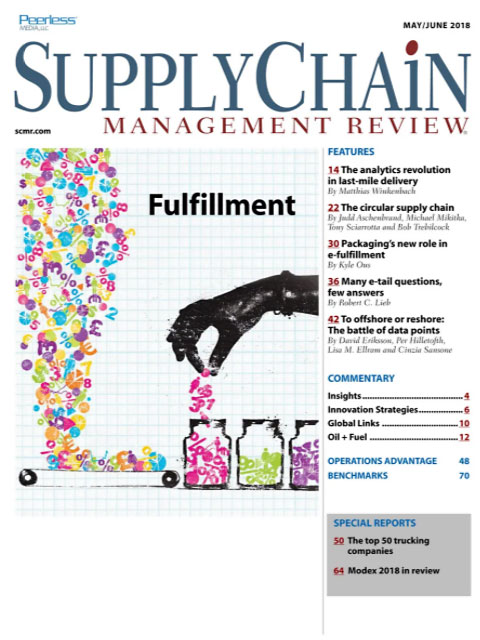Sorry, but your login has failed. Please recheck your login information and resubmit. If your subscription has expired, renew here.
May-June 2018
Last month, I was in Atlanta at the Modex trade show. In one sense, it is a tribute to the automation technologies managing today’s distribution networks. And, I’m not only talking about automated materials handling systems, but also the software and NextGen technologies such as robotics, wearable technologies, including smart glasses and augmented reality solutions and sensors enabling the Internet of Things. In another sense, all of these solutions are coming together to drive fulfillment. With the increase in e-commerce, getting the right product to the right customer at the right time has never been more important. Browse this issue archive.Need Help? Contact customer service 847-559-7581 More options
For many organizations, reverse logistics provides a way to quickly and efficiently obtain returned products for repair, disposal, recycling or refurbishment. For that reason, it is in an organization’s best interest to conduct reverse logistics as efficiently as possible to keep customers satisfied and occupy minimal resources.
Data from APQC’s Open Standards Benchmarking in logistics indicates that a majority of organizations (over 82%) have implemented a returns management process as part of their logistics activities. Nearly half of organizations have implemented formal returns management extensively; what’s more, many have determined that it makes more sense to outsource returns management than to execute the process in house.
Accordingly, APQC has found that most organizations (about 75%) in our survey have implemented the use of third-party logistics (3PL) providers or other external agencies to manage their returns. However, the degree to which organizations use 3PLs varies. About 41% of organizations use 3PLs to some extent, and one-third of organizations use them extensively.

This complete article is available to subscribers only.
Log in now for full access or start your PLUS+ subscription for instant access.
SC
MR
Sorry, but your login has failed. Please recheck your login information and resubmit. If your subscription has expired, renew here.
May-June 2018
Last month, I was in Atlanta at the Modex trade show. In one sense, it is a tribute to the automation technologies managing today’s distribution networks. And, I’m not only talking about automated materials… Browse this issue archive. Access your online digital edition. Download a PDF file of the May-June 2018 issue.For many organizations, reverse logistics provides a way to quickly and efficiently obtain returned products for repair, disposal, recycling or refurbishment. For that reason, it is in an organization's best interest to conduct reverse logistics as efficiently as possible to keep customers satisfied and occupy minimal resources.
Data from APQC's Open Standards Benchmarking in logistics indicates that a majority of organizations (over 82%) have implemented a returns management process as part of their logistics activities. Nearly half of organizations have implemented formal returns management extensively; what's more, many have determined that it makes more sense to outsource returns management than to execute the process in house.
Accordingly, APQC has found that most organizations (about 75%) in our survey have implemented the use of third-party logistics (3PL) providers or other external agencies to manage their returns. However, the degree to which organizations use 3PLs varies. About 41% of organizations use 3PLs to some extent, and one-third of organizations use them extensively.
SC
MR


Latest Supply Chain News
- Early bird pricing expires soon for NextGen Supply Chain Conference registration
- A $125M Portland project seeks to revitalize a historic community, U.S. manufacturing
- Innovations in last-mile delivery and their strategic impact
- Embrace resistance for greater success with change management
- 6 Questions With … Steve Johanson
- More News
Latest Resources

 Explore
Explore
Education News
- Early bird pricing expires soon for NextGen Supply Chain Conference registration
- Squint named NextGen Supply Chain Conference Start-Up Award winner
- Keynotes from Procter & Gamble, Johnson & Johnson & Whirlpool execs highlight NextGen conference agenda
- Cybersecurity as a major supply chain risk domain
- Walmart named NextGen Supply Chain Visionary Award winner
- We asked LinkedIn readers to suggest supply chain books to read. Here’s what they said
- More Education
Latest Education Resources

Subscribe

Supply Chain Management Review delivers the best industry content.

Editors’ Picks





